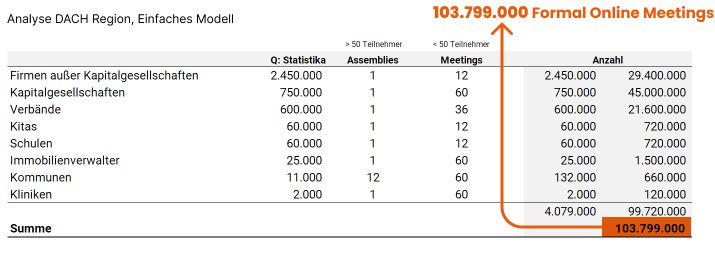Online meetings are more environmentally friendly than face-to-face meetings; but they are not completely CO2 neutral. By supporting your meetings with the right FOM tool, you can further improve your carbon footprint.
An editorial contribution from the FOM Magazine
Face-to-face events not only generate costs for the organizers and participants, but also for the environment. For example, when a major corporation invites shareholders to its annual general meeting, thousands of shareholders from all over the world often make the pilgrimage to the meeting venue. But even smaller meetings, such as committee meetings or ordinary business trips, contribute significantly to global CO2 emissions.
Climate Sinner Presence Meeting
The German Transport Club (VCD) estimates that Germany could save up to three million tons of greenhouse gas per year if companies across the country replaced business trips with video conferences. According to the VCD's calculations, business trips result in 12 million tons of greenhouse gas released each year. According to the Federal Environment Ministry, this corresponds to just under 1.5 percent of the greenhouse gases emitted in Germany each year.
The main reason for the miserable CO2 balance of attendance events is the journey to and from the event. Even a train ride from Stuttgart to Berlin causes 65 kilograms of CO2 - traveling by car or even by plane causes much more. Jens Clausen, one of the authors of the VCD study, says 700,000 cars could be made redundant by establishing digital meetings.
Savings potential through FOMs
According to estimates by the FOM software provider Linkando, up to 100 million formal meetings are held in Germany every year. Private companies account for the lion's share, along with formal meetings of associations, clubs, schools, municipalities and more.

However, it is not only the frequency of meetings that is decisive for the CO2 savings potential of formal meetings, but also their number of participants. General meetings often have thousands of participants. Association and club meetings are often attended by hundreds of people. Even the participants in committee meetings can quickly number in the dozens.
Data transfer consumes power
Even online meetings are not completely CO2-neutral. Emissions are caused by data centers, communication channels and the operation of end devices.
According to the Federal Environment Agency (UBA), the type of data transfer in particular is decisive for the CO2 balance. For example, a video stream in HD quality via fiber optic cable is 50 times more efficient in terms of CO2 emissions compared to a UMPTS transmission via a G3 data network.
Nevertheless, online meetings have a significantly lower impact on the environment than face-to-face meetings. Even with only a five-kilometer journey by car, video conferencing is the more environmentally friendly alternative - assuming four people take part in the meeting. Most formal meetings require significantly more participants.
Reduce image transmission
The environmental costs of digital meetings can be further reduced. According to the study "The overlooked environmental footprint of increasing Internet use" in the journal "Resources, Conservation and Recycling," meeting organizers could save greenhouse gases by foregoing video streaming.
The study shows that 15 meeting hours per week caused CO2 emissions of 9.4 kilograms per month. Without image transmission, the figure would be just 377 grams. Extrapolated to all online meetings in Germany, this would result in enormous CO2 savings potential. This is all the more true for international meetings, especially for participants from countries whose energy mix consists of CO2-intensive technologies.
Agenda and speaker management
Organizers can compensate for the loss of interaction due to the missing image with structure and meeting management. This also turns a normal online meeting into a Formal Online Meeting, i.e. a FOM. Special FOM software includes, among other things, an agenda and speaker management system that allows participants to speak by hand message - if necessary also with a picture. Instead of having all cameras running constantly, modern FOM software can selectively include only the relevant people in the picture.

FOM software can therefore make an important contribution to the sustainability of formal meetings and also general online meetings. Compared to traffic-intensive face-to-face meetings, the carbon footprint of FOMs is significantly positive. However, it is not zero and organizers can further reduce their carbon footprint through environmentally friendly speaker management. The prerequisite for this is that the software provider offers the necessary functions in the first place. Sustainability aspects should therefore already play a decisive role in the selection of the FOM tool.







